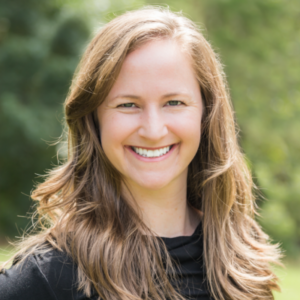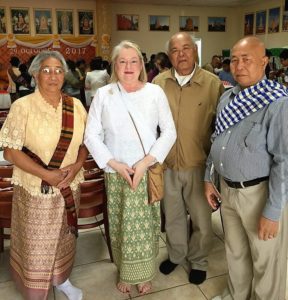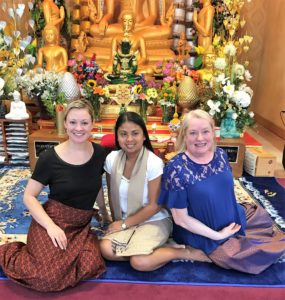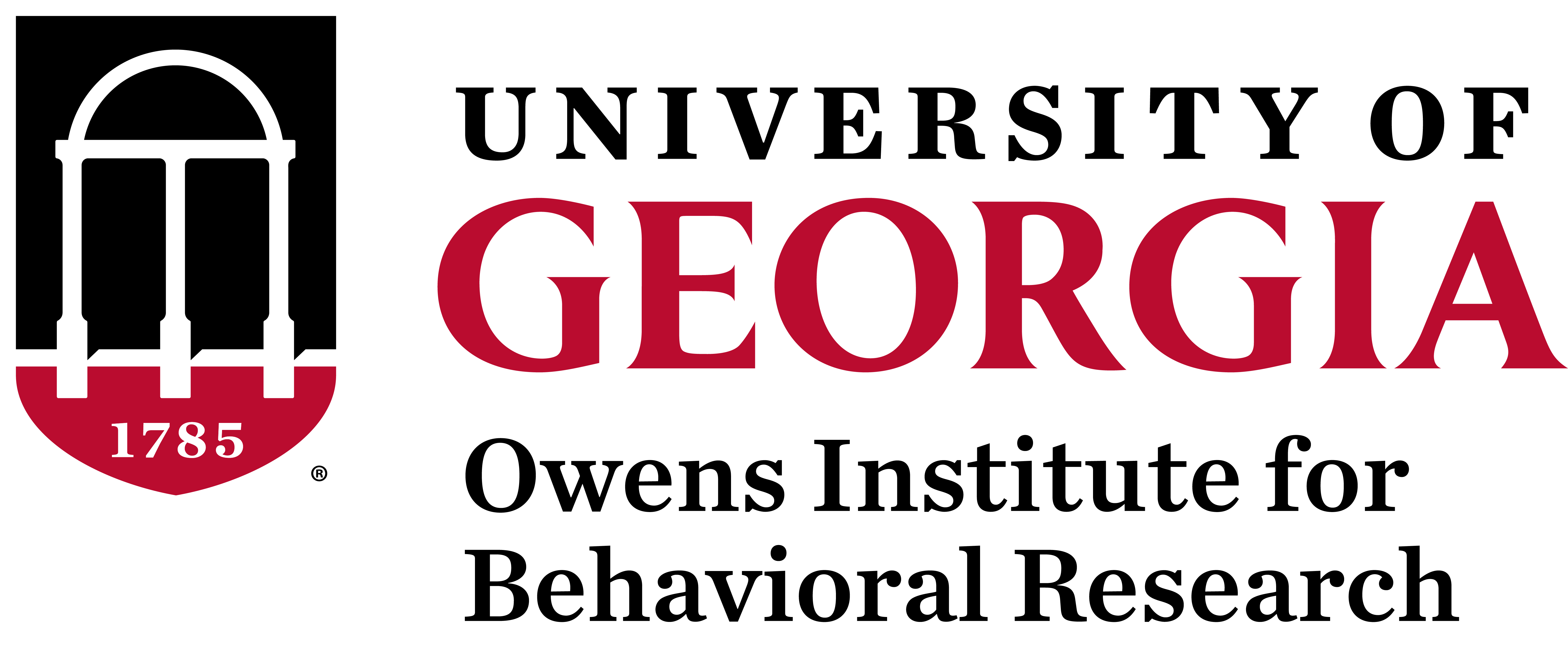Research Spotlight

Dr. Katherine Ehrlich (Psychology)
Interviewed by Andrea Horsman
OIBR Fellow Katherine Ehrlich, Assistant Professor with joint appointments in the Department of Psychology and the Center for Family Research, has been a very busy lady. This junior faculty member has recently been awarded three grants totaling close to $2.5 million dollars! All three research projects focus on how children’s social experiences shape their mental and physical health.
Dr. Ehrlich received her B.A. at Washington & Lee University, her Ph.D. in Psychology at the University of Maryland, and she completed a postdoctoral fellowship at Northwestern University. Dr. Ehrlich’s research, which lies at the intersection of developmental, clinical, and health psychology, focuses on how social experiences, such as early adversity, close relationships, and socioeconomic status are associated with physical health across the lifespan. In addition to utilizing a variety of methods to evaluate social and emotional functioning, her research incorporates a number of health assessments, including clinical health outcomes, measures of cellular function, and adaptive immunity. Dr. Ehrlich is a recipient of pre- and post-doctoral Ruth L. Kirschstein National Research Service Awards, a NARSAD Young Investigator Grant, an R03 from the National Institute of Child Health and Human Development, and was named a Rising Star by the Association for Psychological Science.
Dr. Ehrlich received $150,542 funding for her NIH R03 (NICHD) proposal entitled “Parental Depression and the Early Origins of Disease Across Three Generations.” When Katie joined UGA in 2016, she began working closely with Dr. Gene Brody (HDFS) and colleagues at the Center for Family Research (CFR) where she got involved in the ongoing longitudinal study of African American families (SHAPE). Youth who joined the study at age 11 are now young adults, and many of them have children of their own.
As part of this grant, Dr. Ehrlich will examine how fluctuations in parents’ (G1) depressive symptoms across a 10-year period are associated with children’s (G2) depressive symptoms and pre-disease risk factors when they reach young adulthood. In addition, they will conduct a pilot study of 60 (G3) children to evaluate links between (G1) and (G2) functioning in relation to (G3) youths’ psychosocial, behavioral, and health measures. This project will set the foundation for recruiting a third generation to the sample, which will then be extended to future projects and will allow them to address questions about the intergenerational transmission of health disparities.
Beginning in January 2019, Dr. Ehrlich will begin work on her Brain & Behavior Research Foundation (NARSAD Young Investigator) grant entitled “Skin Deep Resilience, Proinflammatory Phenotypes, and Depression Risk in Youth” with her postdoc mentors and collaborators Dr. Greg Miller and Dr. Edith Chen with Northwestern University. Also part of the project team is Dr. Gene Brody (HDFS) and Dr. Steve Beach (Psychology). The team has identified an intriguing and initially counterintuitive phenomenon. When studying resilient young adults in longitudinal samples – the participants who, despite adversity, avoided drugs, went to college, and showed few depressive symptoms – were surprisingly not resilient when it came to assessments of their physical health. In fact, these individuals fared worse than their peers, which suggested that the self-control and perseverance it required to “make it” in society was taking a toll on their health.
This research grant is important because studies of “skin deep resilience” have primarily focused on young adults. This project will recruit children (ages 8-14 years old) to examine whether these processes are evident as early as childhood. This developmental question is of particular importance because it will help to establish a time course for when diverging patterns of risk and resilience start to develop. Further, little is known about the underlying physiology that might explain why these resilient individuals develop such poor physical health in adulthood. As part of this study, they will evaluate children’s proinflammatory phenotypes by testing how aggressively their cells respond to bacteria. One hypothesis is that high levels of self-control, while protective for outcomes like academic performance and behavior in the classroom, might be associated with a more aggressive inflammatory response.
Dr. Ehrlich was also recently awarded the NIH Director’s New Innovator Award in the amount of $2,222,879 for her project “Innovative Approaches to the Study of Social Determinants of Health in Children.”
The NIH Director’s New Innovator Award, established in 2007, supports highly innovative research from promising Early Stage Investigators (defined as those within 10 years of completing their terminal research degree or postgraduate clinical training and who have not yet received substantial NIH support). This award is part of the Common Fund’s High-Risk, High-Reward Research program, which was created to accelerate the pace of biomedical discoveries by supporting exceptionally creative scientists with highly innovative research. The program seeks to identify scientists with high-impact ideas that may be risky or at a stage too early to fare well in the traditional peer review process. The program encourages creative, outside-the-box thinkers to pursue exciting and innovative ideas in any area of biomedical research relevant to the NIH mission.
This project began in 2017 when Dr. Ehrlich participated in an UGA Presidential Seed Grant challenge that encourages interdisciplinary research on campus. She submitted an application to study how stressful life experiences might dampen children’s antibody production following influenza vaccination. It was a collaborative project with Dr. Ted Ross, Director of the Center for Vaccines and Immunology at UGA. That project was not funded, but the process of putting together the application solidified Katie’s interest in using vaccinations as a way to evaluate how stress might influence children’s immune systems.
Later that year, Katie applied for the NIH New Innovator Award with the same general focus. The grant mechanism appealed to her for a couple reasons. First, the application was unlike other traditional R01 proposals – instead of a tightly focused and clear plan with preliminary data that is submitted for an R01, the New Innovator Award asks you to think about a scientific challenge that you want to address and how you might take a novel approach to solving that problem. No preliminary data are required, nor do they require the specification of a clear experimental plan (and NIH discourages applicants from submitting specific aims).
The New Innovator Award research is important because the examination of links between social stressors and physical health is difficult to do in childhood, in part because children are generally healthy and show few signs of outward disease. This research will allow them to circumvent some of the challenges they’ve previously faced when trying to examine health markers that have little variability or prognostic utility in childhood. They will be looking at children’s response to vaccination as an indicator of physical health – a measure that can be considered an in vivo marker of immune function with clinical health relevance.
The odds of success for winning the NIH New Innovator Award are low. It was determined that, out of 600 funded proposals over the last 11 years, only seven other awardees were from psychology departments. So… congratulations Dr. Ehrlich on this huge accomplishment!
Dr. Ehrlich feels that access to unique resources at UGA were a major part of her grant successes. As a participant of OIBR’s Grant Development Program, she workshopped the project idea throughout Year 1 of the program and those discussions plus the focused time to write allowed her to put forward a competitive proposal. The Clinical and Translational Research Unit (CTRU) is a phenomenal facility, with ample space for data collection (e.g., patient rooms) and the staff to help with the visits. In particular, their nursing team is invaluable for blood draws and vaccine administration. Working with vaccines and evaluating antibody production was completely new for Katie, and she was fortunate to rely on the Center for Vaccines and Immunology center (and director Ted Ross, in particular) to assist with study design, sample assays, and answering all of the questions that pop up with this research.
“In addition to being an incredibly kind and supportive mentor, Dr. Gene Brody (HDFS) has encouraged me so much along the way. Also, the collaborative and supportive nature at CFR has far surpassed my expectations for what it would be like to work at UGA, and as a result of CFR’s support, I have been able to move quickly on these applications. I’m confident that these proposals were funded at least in part because of the support and infrastructure that CFR provides for assisting with research,” said Dr. Ehrlich.
So what are the long term goals for this young investigator? Dr. Ehrlich is interested in how these processes play out over time, both within individuals and across generations. She and Dr. Brody are planning to expand on the R03 project to recruit all of the G3 children in the study so that they can more fully examine how experiences in one generation carry forward to the next. She is also interested in new techniques that will provide better insight into the biological mechanisms that might help explain, in part, how social experiences come to influence health.
When asked what she finds most rewarding about her research, Katie replied, “It’s hard to pick just one part! I love how interdisciplinary and collaborative my work is. There’s always something new to learn and a new potential collaboration on the horizon. I’m also really excited about how our work has the potential to inform interventions and public policy – for me, it brings deeper meaning and more urgency to our work.”
To get updates about the progress on all of these projects, please visit Dr. Katie Ehrlich’s lab The Health and Development Laboratory here.


SPRING 2018
Dr. Denise Lewis (HDFS)
Interviewed by Andrea Horsman
OIBR Affiliate Denise Lewis, Associate Professor in Human Development and Family Science, was awarded a $3+ million grant from National Academies of Sciences, Engineering, and Medicine for her project entitled “Community and Family Resilience, Strength and Well-being: Sociocultural Influences on Cambodian and Laotian Refugee Communities’ Responses to Environmental Challenges.” We recently caught up with Denise and asked her to share some information about her project.
How did you first get involved with this project?
I read the request for proposals in October 2016 and began crafting ideas for the project. I knew I’d need a strong team so I traveled to the Alabama coast to meet with leaders in the Cambodian and Laotian communities (where I have more than 20 years of research history). I initially worked with my long-time collaborator, Dr. Desiree Seponski (HDFS) and four community partners. As ideas evolved, I added faculty from the College of Public health: Dr. Sarah DeYoung aids in community psychology research, and there is a disaster preparedness assessment and training component as well.
Tell me about this project and why it is important-
Southeast Asian refugee families living along coastal Alabama have endured cumulative effects of multiple traumas. These include Cambodian refugees’ flight during the Pol Pot genocide that led to approximately two million deaths and an exodus from Laos and Vietnam at the end of the United States-Vietnam War. Families from those nations witnessed deaths of loved ones and continue to experience separations caused by resettlement and adjustment to life as immigrants/refugees. Many families resettled in the United States (US) found that local populations were far from welcoming. Members of the Alabama coastal community faced hostility as they began work in the seafood industry. More recent traumas include the massive destruction caused by Hurricane Katrina and the Deepwater Horizon oil spill. These traumatic experiences can create long-felt social pain and mental anguish, but can also serve as mobilizers for community resilience. It is this foundation of individual, family, and community resilience from multiple traumas that this project will explore.
This project will contribute to three main sociocultural objectives of human dynamics tightly linked to resilience: (1) Engagement of the refugee community through collaboration on, development, testing, and implementation of empirically-informed, community-driven, and community-based programs that produce immediately usable information to prepare for, adapt to, and mitigate effects of environmental challenges; (2) Training community members in research, grant writing, and hazardous risk management skills to facilitate sustainability of developed programs/processes; (3) Creation of models of community-based risk reduction and household production of health including individual, family, and community intersections of sociocultural factors associated with strengths and vulnerabilities.
Tell me about someone who has influenced your decision to work with these communities-
More than 20 years ago, I volunteered to teach English to a Cambodian monk who had just arrived in the United States. One of the community leaders, Mr. Heang Bun Chhun, organized a group of older couples to teach me about Cambodia and Cambodian life- ways as I was teaching the monk. Mr. Chhun’s strength, his willingness to teach and tell his and other refugees’ stories, and his dedication to advancing the good of his community have strongly influenced my decision to continue my work with this and other refugee communities. Through him, I’ve learned that even the most outwardly disadvantaged people possess an inner strength that can be brought to bear on nearly overwhelming circumstances. Refugees, such as those I work with in Alabama, arrived in the US with no material possessions, very limited to no English language skills, and were filled with grief over the loss of many, many family members and their homes, inspire me through their strength and resilience.
What has surprised you most about working on this project?
The most surprising aspect of this project is the willingness of so many members of these two refugee communities to work together, with me and others, to build a stronger community of identity. It is obvious to me that they want to see their cultures survive and thrive. They want to be sure they are providing a foundation for future generations who are proud of their heritage.
What do you find most challenging about this research project?
The greatest challenge is working across three different languages. Although an individual may speak one or more languages, they may not be literate in any of them. Fortunately, I have four main community partners (2 Cambodian and 2 Laotian) who are all fluent in their native language and in English. I also have four translators/transcribers who assist and an additional 20+ members of a cultural advisory board. Without individuals such as these working with me, it would be extremely difficulty to accomplish the goals of this project.
Tell me about some of the people you’ve met-
I’ve known Mr. Heang Bun Chhun for more than 20 years. He escaped from Cambodian in 1976 after losing most of his family. In the early 1980s, he and two other Cambodian refugee men purchased about 180 acres of forestland and created a Cambodian village. He has been my chief Cambodian collaborator since 1996 and is now a close friend. Samoeuy Chim is another Cambodian collaborator. She arrived in the US as a child and has become a very successful businesswoman—she owns several service stations and a chain of doughnut shops. She is constantly “giving back” to members of the local refugee community. Her quiet generosity is inspiring. I’ve known her for more than 20 years as well. I am well known in the Cambodian community—a factor that made creating and now implementing this project a reality.
It has been a pleasure to begin to know members of the Laotian community. The two communities tend to interact so, over the years, I had met many Laotian refugees. However, it wasn’t until Mr. Chhun organized a community meeting in 2016 with leaders from both the Cambodian and Laotian communities that I really began to know Laotian refugees. The primary Lao leader is Mr. Vi- sanou Khamphouy. He arrived from Laos about 40 years ago and is the head of a very large Laotian family. He also engages in mul- tiple community-building activities. These three individuals (Chhun, Chim, & Khamphouy) are collaborators on the grant. There is a fourth individual, Khiaw Srihanouvong, who volunteers his time in the community and in service to the goals of the project. Mr.
Srihanouvong is highly engaged in outreach and in organizing volunteers to serve the communities. He has become a vital part of the project. All of these individuals display strong commitments to their communities and to the project and provide input into how to best meet the needs of their communities.
What is your personal philosophy on what should be done about refugee and immigrant communities?
We should talk to refugee communities about what they see as their greatest need and provide opportunities that respond to those needs. We must recognize the strengths and resilience within these groups. It is vital that we embrace their knowledge, walk with them as partners and, eventually, move out of the way so they can build communities in such a way that they are able to thrive instead of remain in a state of marginality and dependency.
What do you think will change over the next five years?
These communities will thrive by engaging in culturally relevant community building. I already see (and hear) plans for teaching children the languages and traditional dances. Community members are excited about the upcoming community grant writing course (happening in May) and how they’ll work together on issues they have identified in their communities as needing additional funds to address.
What else can you tell me about this research?
This research-practice project has the potential of making generations-long changes to benefit these two Southeast Asian refugee communities.
What benefits (if any) have you experienced by working with OIBR on this grant?
The greatest benefit I’ve received from OIBR on this grant is that I have a team of experienced and knowledgeable people who’ve worked with me from the very beginning to address all the requirements of the funding agencies, to help me think through the needs of the project, and to assist with hiring, budgeting, and managing the grant so that I can focus on the science and implementation of the project.
Where can people go if they want to learn more about this project?
People can learn more by visiting our website http://www.fcs.uga.edu/hdfs/clcsrp or our Facebook page @CamLaoStrong.
